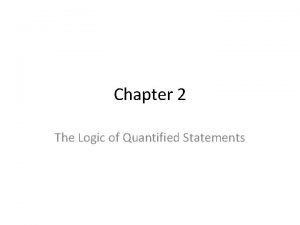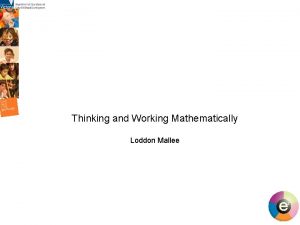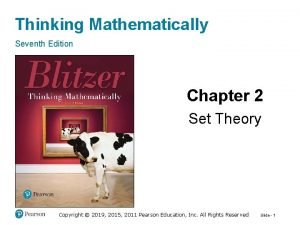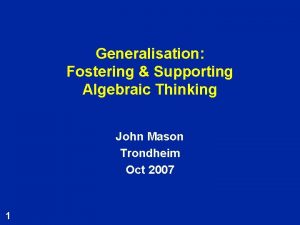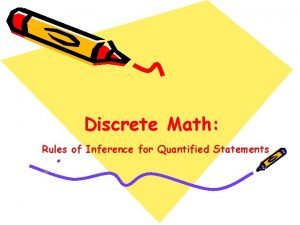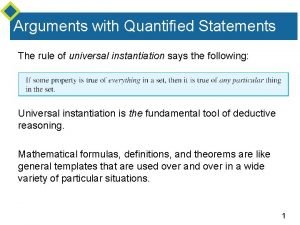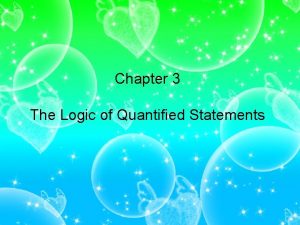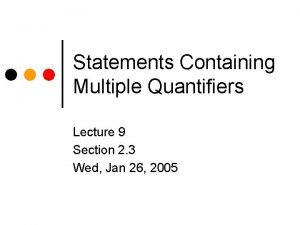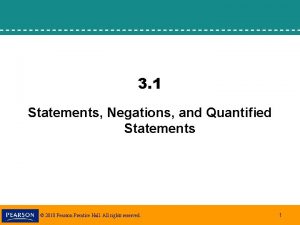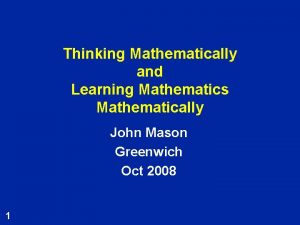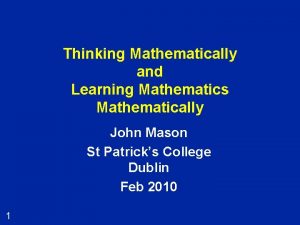Thinking Mathematically Statements Negations and Quantified Statements Statements








- Slides: 8

Thinking Mathematically Statements, Negations, and Quantified Statements

Statements A “statement” is a sentence that is either “true” or “false” but not both at the same time. Examples “Miami is a city in Florida” is a true statement. “Two plus two equals five” is a false statement. “Today is Friday” is a statement that is sometimes true and sometimes false, but never both true and false at the same time. “Go to the grocery store” is not a statement. It is a command is neither true nor false.

Statements - “Negation” The “negation” of a statement is another statement that has the opposite “truth value. ” That is when a statement is true its negation is false and when the statement is false its negation is true. Examples “Miami is not a city in Florida” is the negation of the statement “Miami is a city in Florida”. “Two plus two is not equal to five” is the negation of the statement “Two plus two equals five”. Be careful! “Two plus two equals four” is a true statement but it is not the negation of “Two plus two equals five”.

Statements - “Symbolism” Just as x can be used as a name for a number, a symbol such as p can be used as a name for a statement. When p is used as a name for a statement the symbols ~p are used as a name for the negation of p. Examples Let p stand for “Miami is a city in Florida. ” Then ~p is the statement “Miami is not a city in Florida. ”

“Quantified” Statements A “quantified” statement is one that says something about “all”, “some”, or “none” of the objects in a collection. Examples “All students in the college are taking history. ” “Some students are taking mathematics. ” “No students are taking both mathematics and history. ”

“Equivalent” Statements In any language there are many ways to say the same thing. The different linguistic constructions of a statement are considered equivalent. Example “All students in the college are taking history. ” “Every student in the college is taking history. ” Example “Some students are taking mathematics. ” “At least one student is taking mathematics. ”

Negating Quantified Statements The negation of a statement about “all” objects is “not all”. “Not all” can often be expressed by “some are not. ” Examples p : All students in the college are taking history. ~p : Some students in the college are not taking history.

Negating Quantified Statements The negation of a statement about “some” objects is “not some”. “Not some” can often be expressed by “none” or “not any. ” Examples p : Some students are taking mathematics. ~p : None of the students are taking mathematics.
 Universal conditional statement examples
Universal conditional statement examples Negations in math
Negations in math Thinking and working mathematically
Thinking and working mathematically Thinking mathematically 7th edition
Thinking mathematically 7th edition Thinking mathematically john mason
Thinking mathematically john mason Rules of inference for quantified statements
Rules of inference for quantified statements Universal modus tollens example
Universal modus tollens example Quantified statement examples
Quantified statement examples Statements with multiple quantifiers
Statements with multiple quantifiers
